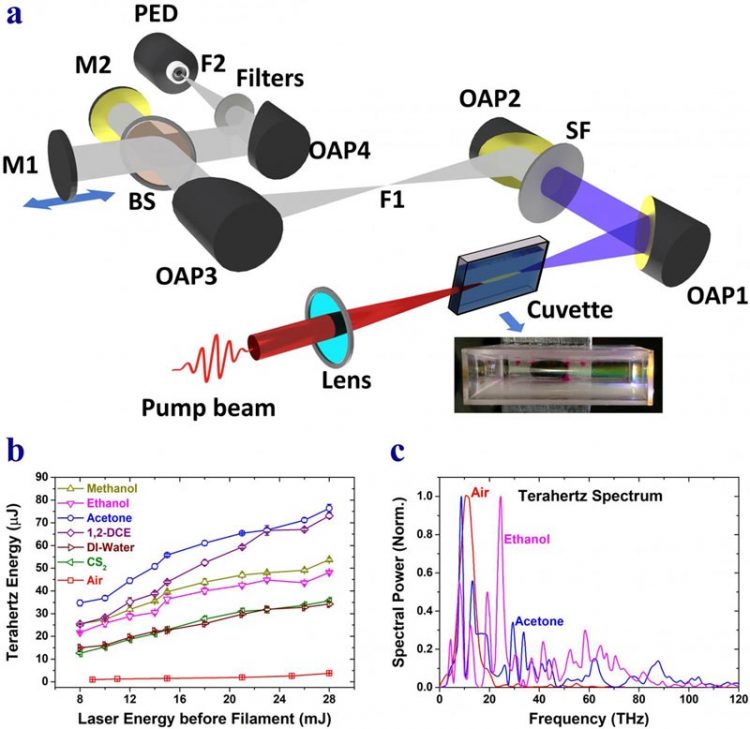Liquids take a shine to terahertz radiation

(a) A high power laser pulse ionizes and creates plasma in a common laboratory liquid like acetone or dichloroethane or even water. The plasma can be seen as a long line along the length of the tube containing the liquid (see inset). This line is called a filament and it radiates, among others, copious terahertz radiation. (b) Integrated terahertz energy obtained from various liquids and air. (c) Power spectrum of terahertz obtained from the filamentation of acetone, ethanol and air. Credit: Indranuj Dey, G. Ravindra Kumar
The search for new and brighter radiation sources is an enduring quest in science and technology [1,2]. While there are many sources across the entire electromagnetic spectrum, the terahertz region (wedged between the infrared/optical and the microwave regions) has been a challenge and it is only in the last twenty years that sources have started becoming available.
High power terahertz radiation has typically been available from large, complex machines like Free Electron Lasers. Compact sources, relying on semiconductor antennas and special crystals excited by visible/infrared femtosecond laser pulses, have very limited energy outputs, typically in the nanojoule (billionth of a joule) level or lower.
They are not useful for many applications. High power femtosecond lasers have however, excited terahertz emission that are a thousand times larger (microjoules) from a plasma formed in air, under special conditions [3].
For a long time, researchers in this area have believed that liquids could not give out significant terahertz radiation, because they would efficiently reabsorb whatever was generated. Yet, this is where the TIFR researchers proved successful. In their experiments, they irradiated common laboratory liquids like methanol, acetone, dicholorethane, carbon disulphide and even water, with moderate energy femtosecond laser pulses, ionizing the liquid and forming long plasma channels called filaments.
To their delight they measured energies as high as 50 microjoules, thousands of times larger than the energies emitted by most existing sources and 10-20 times larger than those produced from air. Their careful characterization and systematic study showed that the experimental conditions were simpler than those needed for air.
The mechanism that facilitates the large output (in spite of the deleterious absorption) has emerged from models used by their theoretical collaborators from the Institute of Electronic Structure and Laser, Foundation for Research and Technology Hellas, Greece and Ecole Polytechnique, Paris. The essence of this model is that the femtosecond laser pulse induces secondary emissions in the liquid which would then combine with the incident laser pulse to produce the observed terahertz radiation.
The TIFR researchers are bullish about the applications of their liquid source, the brightest among compact, tabletop sources. They foresee many applications in terahertz imaging, material analysis, explosives detection and terahertz nonlinear optics. This new source certainly increases the stock of terahertz radiation. Shall we say, terahertz liquidity boosted?
###
References:
[1] Tonouchi, M. “Cutting-edge terahertz technology.” Nat. Photonics 1, 97-105 (2007).
[2] Baierl, S. et al. “Nonlinear spin control by terahertz-driven anisotropy fields.” Nat. Photonics 10, 715-718 (2016).
[3] Kim, K. Y., Taylor, A. J., Glownia, J. H. & Rodriguez, G. “Coherent control of terahertz supercontinuum generation in ultrafast laser-gas interactions.” Nat. Photonics 2, 605-609 (2008).
Media Contact
All latest news from the category: Physics and Astronomy
This area deals with the fundamental laws and building blocks of nature and how they interact, the properties and the behavior of matter, and research into space and time and their structures.
innovations-report provides in-depth reports and articles on subjects such as astrophysics, laser technologies, nuclear, quantum, particle and solid-state physics, nanotechnologies, planetary research and findings (Mars, Venus) and developments related to the Hubble Telescope.
Newest articles

First-of-its-kind study uses remote sensing to monitor plastic debris in rivers and lakes
Remote sensing creates a cost-effective solution to monitoring plastic pollution. A first-of-its-kind study from researchers at the University of Minnesota Twin Cities shows how remote sensing can help monitor and…

Laser-based artificial neuron mimics nerve cell functions at lightning speed
With a processing speed a billion times faster than nature, chip-based laser neuron could help advance AI tasks such as pattern recognition and sequence prediction. Researchers have developed a laser-based…

Optimising the processing of plastic waste
Just one look in the yellow bin reveals a colourful jumble of different types of plastic. However, the purer and more uniform plastic waste is, the easier it is to…


